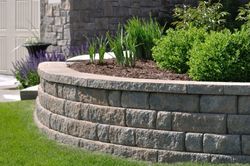
Retaining walls can reduce soil erosion, promote stability for hilly areas, and reduce flooding. Many people make these borders with limestone, a sedimentary rock that is used in concrete and roadbuilding. Here are three reasons to consider the stone for a retaining wall.
Why Should You Use Limestone Retaining Walls?
1. Increased Curb Appeal
Limestone is made of crushed calcium carbonate and can be cream, gray, yellow, blue, or beige. Some stones have a lot of veining, or color variability, while others are monotone.
You’re sure to find a variety that matches your home. Select a color that contrasts with the exterior finish of the house, like gray stones for blue siding or a white limestone retaining wall for a red brick home.
2. Easy Installation
Limestone is cut out of quarries, or deep pits, and shaped into brick, making it easy to stack and create a sturdy retaining wall by hand. You or an installation team won’t have to cut the stone as it will arrive ready to go.
 Some homeowners prefer a retaining wall that features one size of limestone bricks that are staggered to promote stability. Others vary stone sizing and cap their walls with longer, thinner slabs to add interest and create a top that serves as seating. This design is perfect for surrounding fire pits or enclosing patio areas.
Some homeowners prefer a retaining wall that features one size of limestone bricks that are staggered to promote stability. Others vary stone sizing and cap their walls with longer, thinner slabs to add interest and create a top that serves as seating. This design is perfect for surrounding fire pits or enclosing patio areas.
3. Low Maintenance
You’ll never need to replace sections of a limestone wall because of corrosion or rot, and you won’t need to power wash this material to remove algae or dust. If plants grow through the areas between the bricks, consider weeding them and adding gravel between the stones to block the light and reduce the chances of repeat weed growth.
Homeowners interested in creating retaining walls should contact Ashcraft Sand & Gravel in the Ohio Tri-State area. This family-owned and -operated business has been serving customers since 1977, offering gravel delivery and sand services. Call the Cleves-region location at (513) 367-5700 or visit the website for information on their construction projects, bulk orders, and long-term client collaborations.
About the Business
Have a question? Ask the experts!
Send your question

